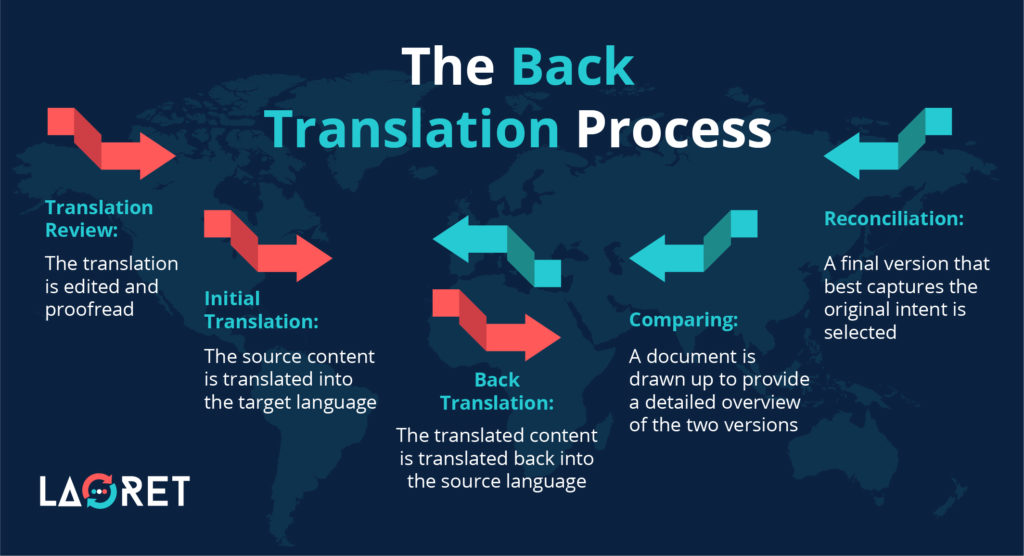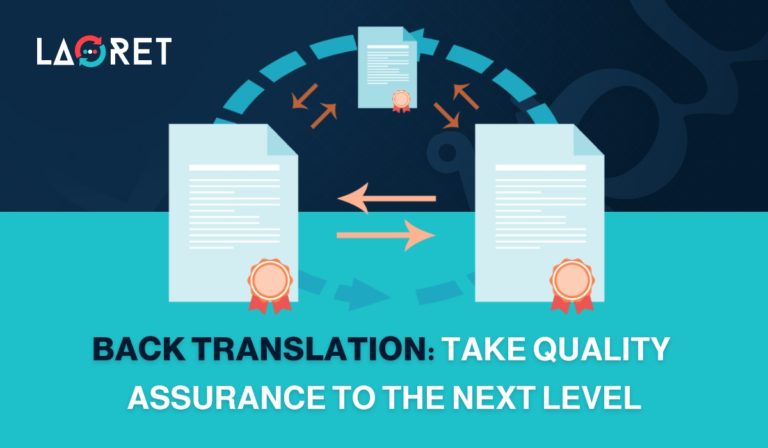Back Translation: Take Quality Assurance To The Next Level
There are certain types of industries where translation quality can make or break a business. Legal, medical, or technical content where accuracy and strict regulatory requirements are vital often needs an extra level of quality assurance.
This is where Back translation services can play an important role. Learn more about what back translation is, when you should apply it (and when not!), and which content types benefit most from it.
What Is Back Translation?
Back translation, also referred to as Reverse Translation, retranslates content back into the source language (the original language). For example, if you have requested a translation project from English to French, the French content will once again be translated into English. The initial translation and the back translation are then compared with one another so that accuracy and quality are verified. This makes back translation an important measure of quality assurance (QA).
A Translation Management System (TMS) is a type of software, designed to optimize the translation process. Whether your business requires a large amount of translated content regularly or runs multiple translation projects at once, so much time and effort go into that, making things overwhelming for you. That’s where a TMS comes in handy.
Between optimizing the translation process through partial automation and streamlining workflows to optimizing communication between collaborators, the benefits are too many to list in just a few lines.
So, we are dedicating the next section to expanding on the benefits that TMS brings to your translation projects.
This is how the back translation process goes:
- The source content is translated into the target language
- The translation is edited and proofread
- The translated content is translated back into the source language in a way that literally conveys the meaning of the original translation
- A comparison is made, and a document is drawn up to provide a detailed overview of the different versions.
- The two versions are then reconciled, and a final version of the translation that best captures the original intent is selected.
Back translation can be further subdivided into:
- Single-Back Translation: A team of translators, with no exposure to the initial translation, performs back translation, exactly the way it’s outlined above.
- Double Back Translation: Two independent linguistic teams are assigned the task of providing back translation, and a different linguist will be in charge of the reviewing process. You may like the idea of the back translation services because, as a client, you are invited to be a part of the process. This means that:
- You take part in the QA process, offer your input, and have a final say in which translation works out best.
- You will also enjoy full transparency because you will be provided with the documents that made up the entire process which includes the back translation, the document listing the potential misinterpretation, the comparison between translations, and the reconciliation document where ultimately everything is resolved, and a final choice is made.

Back Translation: To Use Or Not To Use?
It is important to remember that while back translation offers a vital level of QA, that doesn’t mean you should request this service for every translation project you have. Because in reality, quality will always be vital.
So, when will back translation make sense for your project?
Back translation is most useful when you are dealing with highly technical content where technical precision is paramount. Most importantly, back translation is a crucial solution when you are operating in a heavily regulated industry and your translated content should meet legal and regulatory requirements. In that case, back translation is imperative to provide an extra layer of quality, so you can safely submit your translation to the regulatory bodies in question.
In a traditional setting, collaborators carry out these activities that take up too much time of their time (and your project’s time), which can be distracting from their core responsibilities and cause delays in project delivery.
However, in a single platform that’s TMS, you can manage an unlimited number of translation projects (whether different content or the same content for different languages and dialects). The entire process will be automated and organized, eliminating the back-and-forth hassle and time-wasting, manual workflows.
An efficient TMS also has key automation features that you should know about so you can make the most of them
- Automatic Importing and Exporting of resource files. Traditionally, you’ll need someone to handle your resource files. When you have a website localization project, for instance, you’ll need to copy and paste a huge number of strings. But that’s not exactly the practical way to do it. An efficient TMS offers seamless import and export functionality that supports various file formats and automatically identifies and pulls content for translation.
- Optimizing the Translation Process. To guarantee the utmost quality, a translation project typically goes through multiple review cycles including editing, proofreading, and final QA review. And if done manually, the process takes a significant amount of time, going back and forth between revisions, edits, and feedback. This might even get far more complicated, if your project requires back translation, for instance. But that’s exactly the reason why a TMS can be a huge benefit. It streamlines the translation process and facilitates real-time collaboration and communication between your teams. For instance, translators, reviewers, and project managers receive notifications to take over the work. They can upload, store, and download files, all from one place. Also, with private messaging and project management tools, you can coordinate efforts between everyone, increase the productivity of the team, and track the progress of the project.
- Continuous Translation. The consistent flow of importing and exporting content will also support the process of continuous localization. With mobile app localization, for example, updates in features and content are very common. In order to make it all run smoothly, a TMS will regularly import, translate, and export your content.
Medical Content
There are various types of medical content that can benefit greatly from back translation method. These include:
- Medical devices documentation, guidelines, and regulations
- Clinical research
- Clinical trials
- Medical consent forms
What all of these content types have in common is that they need to adhere to the following:
- Accuracy and consistency have to be maintained every step of the way and consistent terminology should be implemented to avoid ambiguities. Any mistakes could prove hazardous for the patient’s health as well as the medical facility’s reputation.
- The medical industry is also defined by very specific laws and regulations for the quality of the medical content and the safety of the patient to be safeguarded. Regulatory authorities including the EU, FDA, EMA, EDQM, and MDR, will have set up a collection of regulations and restrictions on an international, national, and local level.
Pro Tip! For a more detailed overview of the ins and outs of medical translation services, check out our blog Medical Translation: Best Practices That Ensure Accuracy And Consistency
Pro Tip! Want more information on Legal Translation? Check out our blog Multilingual Legal Translation: This Is How Full Accuracy Is Ensured for a full overview of the best practices, and Legal Translation For International Business Expansion for an overview of which types of legal documents will serve you best when expanding your business into new markets!
Financial And Business Document Translation
When it comes to business translation, finances will be at the core of many documents and transactions. Financial translation services should take local regulations and regional considerations into account through careful terminology management and a rigorous QA strategy.
Financial translations will always need to be:
- Linguistically flawless, clear, and effective
- Compliant with local standards depending on the region
- Consistent in terms of terminology and numbers/currencies, depending on the target locale
Vital types of financial documents that are likely to require back translation include:
- Income And Expenditure Reports
- Profit To Loss Statements
- Investment Procedures
- White Papers listing financial research
- Banking Documentation
- Financial Analysis reports
- Insurance Policies
- Trade Agreements
- Fund Prospectus Translation
Surveys and Data Translation
When exploring a new market to expand into, you may very well test the waters and perform market research. A common tool to collect data important to decide on the future of your business is surveys. But this also means that you should get survey translation services. This doesn’t only apply to the questions posed to the prospective clients, but also to the answers you will get in return. Both should be free of any ambiguity.
You may think that you can make it easy on yourself and just offer multiple-choice options. And while you could, research into consumer preference indicates that the opportunity to give actual feedback and open answers is favored by 89% of the consumers.1
Pro Tip! Dive more deeply into every aspect of survey translation in our blogs International Survey Translation: This Is How Accuracy Remains A Priority and Survey Translation & Linguistic Coding: Get Qualitative Feedback And Quantifiable Data
Technical content
Another content type where ambiguity can easily sneak in when proper QA strategies are not applied is technical translation. Technical content, whether manufacturing or engineering content, is highly specialized and will require top quality translation services to make sure clarity, accuracy, and consistency are maintained. Important content types include:
- Operational Instructions
- Proper Handling Description
- Warning & Safety Risk
- Articles & Research Paper Translation
- Reports
- Instruction Sheet
- Software Strings
Any errors that could slip into a flawed translation process without proper QA could lead to compromised procedures, equipment, and documents, which could potentially result in serious legal issues.
Conclusion
Back Translation can be a valuable service for those industries and content types where accuracy and the nuances of language are vital to maintain, and an extra level of QA is imperative.
At Laoret, we provide Single and Double Back Translation in addition to the full scope of our QA strategies. Eager to get started? Reach out to us and request a quote!






